Prioritization of Renewable Energy for Sustainable Electricity Generation and an Assessment of Floating Photovoltaic Potential in Lao PDR
Abstract
1. Introduction
2. Materials and Methods
2.1. Study Area
2.2. RE Prioritization
Analytic Hierarchy Process
2.3. FPV Potential Assessment
3. Results
3.1. RE Prioritization
3.1.1. The Prioritization of All Respondents
3.1.2. Prioritization of the Three Groups
3.1.3. Sensitivity Analysis
3.2. Floating Photovoltaic Potential
4. Discussion: National Power Development Strategy
5. Conclusions
Author Contributions
Funding
Data Availability Statement
Acknowledgments
Conflicts of Interest
Appendix A. Survey Information
| Organization | Position | Working Experience (Average Year) | Number of Respondents | |
|---|---|---|---|---|
| Ministry of Energy and Mines | Department of Energy Policy and Planning | Deputy director general | 14 | 5 |
| Head of division | ||||
| Deputy dead of division | ||||
| Department of Law | Director general | 20 | 2 | |
| Deputy director general | ||||
| Department of Energy Management | Deputy director general | 22 | 1 | |
| Department of Energy and Mines Vientiane Capital | Head of Office | 9 | 1 | |
| Ministry of Natural Resource and Environment | Department of Land | Deputy director general | 11 | 1 |
| Department of Planning and Cooperation | Head of division | 9 | 1 | |
| Ministry of Public Work and Transportation | Department of Cooperation and Planning | Technical Officer | 5 | 1 |
| National University of Laos, Faculty of Economic and Administration | Chief of Public Economic Unit | 15 | 1 | |
| Department of Education and Sports Vientiane Capital | Deputy director general | 21 | 1 | |
| Party’s Commission for Propaganda and Training of Vientiane Capital | Head of Committee | 38 | 1 | |
| Electricite du Laos Generation Public Company | Department of Power Generation | Deputy Manager | 9 | 2 |
| Department of Business Development | Technical Officer | |||
| Lao Energy Security Project | Consultant | 13 | 1 | |
| Academic Researcher | Independent researcher | 13 | 1 | |
| USAID and Australia Mekong Safeguards | Consultant on Energy Planning | 12 | 2 | |
| World Bank Laos | Retired consultant | 50 | 1 | |
| Hiroshima University | Associate professor | 20 | 1 | |
| CHESS Lab, Hiroshima University | Academic researchers (doctoral & Master) | 8 | ||
| Sub-Criteria | Weights |
|---|---|
| Efficiency | 0.360 |
| Resource availability | 0.388 |
| Grid connectivity | 0.253 |
| Investment cost | 0.246 |
| Energy price | 0.311 |
| Service life | 0.247 |
| Operation and maintenance cost | 0.196 |
| Land use | 0.381 |
| CO2 emission | 0.265 |
| Impacts on biodiversity | 0.354 |
| Public acceptance | 0.527 |
| Job creation | 0.473 |
| No. | Project Name | Location (Province) | Installed Capacity (MW) | |
|---|---|---|---|---|
| Hydropower | ||||
| 1 | Nam Sim | Huaphan | 8.4 | |
| 2 | Nam Ao | Xiengkhouang | 15 | |
| 3 | Nam Hinboun downstream | Khammouan | 15 | |
| 4 | Nam Ngum 1 extension Unit 6 | Vientiane | 40 | |
| 5 | Nam Tha | Bokeo | 15 | |
| 6 | Nam Ngiep 2A | Xaisomboun | 12.6 | |
| 7 | Nam Talan | Luangnamtha | 5 | |
| 8 | Nam Ou 3 | Luangprabang | 210 | |
| 9 | Nam Ou 4 | Phonsaly | 132 | |
| 10 | Nam Ou 7 | Phongsaly | 210 | |
| 11 | HouayLamphan downstream | Xekong | 15 | |
| 12 | Nam Theun 1 | Bolikhamxay | 130 | |
| 13 | Nam Hinboun | Khammouan | 30 | |
| 14 | Nam Hong 1 | Xaiyabury | 15 | |
| 15 | Nam Ngao | Bokeo | 15 | |
| 16 | Nam Hao | Huaphan | 15 | |
| 17 | Houaynyoi-Houaykhot | Champasak | 15 | |
| 18 | Nam Mon 1 | Huaphan | 10 | |
| 19 | Houay Kapeur | Saravan | 5 | |
| 20 | Nam Pounglo | Bokeo | 5 | |
| 21 | Nam Phoun | Xaiyabury | 45 | |
| 22 | Nam Samoi | Vientiane | 5 | |
| 23 | Houay Palai | Champasak | 30 | |
| 24 | Nam Tang | Bolikhamxay | 12.8 | |
| 25 | Houaysai Mekong | Bolikhamxay | 13.6 | |
| 26 | Nam Chae | Xaisomboun | 7.5 | |
| 27 | Pak Ngum | Vientiane capital | 80 | |
| 28 | Xebangfai 1 | Savannakhet | 110 | |
| 29 | Luangprabang Mekong | Luangprabang | 60 | |
| 30 | Houay Ho (retirement) | Attapue | 150 | |
| Solar Photovoltaic | ||||
| 1 | Solar farm | Bolikhamxay | 30 | |
| 2 | Floating Solar | Xaisomboun | 300 | |
| 3 | Solar farm | Vientiane capital | 68 | |
| 4 | Solar farm | Khammouan | 50 | |
| 5 | Solar farm | Savannakhet | 50 | |
| Coal Thermal | ||||
| 1 | Coal thermal Namphan | Xiengkhouang | 170 | |
| 2 | Coal thermal (Bualapha) | Khammouan | 200 | |
| 3 | Coal thermal | Savannakhet | 75 | |
| 4 | Coal thermal | Sekong | 100 | |
| Total | 2436 | |||
References
- BP Energy. Statistical Review of World Energy globally consistent data on world energy markets and authoritative publications in the field of energy. BP Energy Outlook 2021, 70, 8–20. [Google Scholar]
- Alizadeh, R.; Soltanisehat, L.; Lund, P.D.; Zamanisabzi, H. Improving renewable energy policy planning and decision-making through a hybrid MCDM method. Energy Policy 2020, 137, 111174. [Google Scholar] [CrossRef]
- Kolagar, M.; Hosseini, S.M.H.; Felegari, R.; Fattahi, P. Policy-making for renewable energy sources in search of sustainable development: A hybrid DEA-FBWM approach. Environ. Syst. Decis. 2020, 40, 485–509. [Google Scholar] [CrossRef]
- Ali, T.; Aghaloo, K.; Chiu, Y.R.; Ahmad, M. Lessons learned from the COVID-19 pandemic in planning the future energy systems of developing countries using an integrated MCDM approach in the off-grid areas of Bangladesh. Renew. Energy 2022, 189, 25–38. [Google Scholar] [CrossRef] [PubMed]
- Shahzadi, I.; Yaseen, M.R.; Iqbal Khan, M.T.; Amjad Makhdum, M.S.; Ali, Q. The nexus between research and development, renewable energy and environmental quality: Evidence from developed and developing countries. Renew. Energy 2021, 190, 1089–1099. [Google Scholar] [CrossRef]
- Sueyoshi, T.; Mo, F.; Wang, D.D. Sustainable development of countries all over the world and the impact of renewable energy. Renew. Energy 2022, 184, 320–331. [Google Scholar] [CrossRef]
- Østergaard, P.A.; Duic, N.; Noorollahi, Y.; Mikulcic, H.; Kalogirou, S. Sustainable development using renewable energy technology. Renew. Energy 2020, 146, 2430–2437. [Google Scholar] [CrossRef]
- Solangi, Y.A.; Longsheng, C.; Shah, S.A.A. Assessing and overcoming the renewable energy barriers for sustainable development in Pakistan: An integrated AHP and fuzzy TOPSIS approach. Renew. Energy 2021, 173, 209–222. [Google Scholar] [CrossRef]
- Munier, N.; Hontoria, E.; Jiménez-Sáez, F. Strategic Approach in Multi-Criteria Decision Making; Springer: Cham, Switzerland, 2019; Volume 275. [Google Scholar]
- Shao, M.; Han, Z.; Sun, J.; Xiao, C.; Zhang, S.; Zhao, Y. A review of multi-criteria decision making applications for renewable energy site selection. Renew. Energy 2020, 157, 377–403. [Google Scholar] [CrossRef]
- Kumar, A.; Sah, B.; Singh, A.R.; Deng, Y.; He, X.; Kumar, P.; Bansal, R.C. A review of multi criteria decision making (MCDM) towards sustainable renewable energy development. Renew. Sustain. Energy Rev. 2017, 69, 596–609. [Google Scholar] [CrossRef]
- Chiu, W.H.; Lin, W.C.; Chen, C.N.; Chen, N.P. Using an analytical hierarchy process to analyze the development of the green energy industry. Energies 2021, 14, 4452. [Google Scholar] [CrossRef]
- Chanchawee, R.; Usapein, P. Ranking of renewable energy for the national electricity plan in Thailand Using an Analytical Hierarchy Process (AHP). Int. J. Renew. Energy Res. 2018, 8, 1553–1562. [Google Scholar]
- Ahmad, S.; Tahar, R.M. Selection of renewable energy sources for sustainable development of electricity generation system using analytic hierarchy process: A case of Malaysia. Renew. Energy 2014, 63, 458–466. [Google Scholar] [CrossRef]
- Al Garni, H.; Kassem, A.; Awasthi, A.; Komljenovic, D.; Al-Haddad, K. A multicriteria decision making approach for evaluating renewable power generation sources in Saudi Arabia. Sustain. Energy Technol. Assess. 2016, 16, 137–150. [Google Scholar] [CrossRef]
- Mirjat, N.H.; Uqaili, M.A.; Harijan, K.; Mustafa, M.W.; Rahman, M.M.; Khan, M.W.A. Multi-criteria analysis of electricity generation scenarios for sustainable energy planning in Pakistan. Energies 2018, 11, 757. [Google Scholar] [CrossRef]
- Ahmad, S.; Nadeem, A.; Akhanova, G.; Houghton, T.; Muhammad-Sukki, F. Multi-criteria evaluation of renewable and nuclear resources for electricity generation in Kazakhstan. Energy 2017, 141, 1880–1891. [Google Scholar] [CrossRef]
- Abdul, D.; Jiang, W.; Tanveer, A. Prioritization of renewable energy source for electricity generation through AHP-VIKOR integrated methodology. Renew. Energy 2022, 184, 1018–1032. [Google Scholar] [CrossRef]
- Dinmohammadi, A.; Shafiee, M. Determination of the most suitable technology transfer strategy for wind turbines using an integrated AHP-TOPSIS decision model. Energies 2017, 10, 5. [Google Scholar] [CrossRef]
- Ayik, A.; Ijumba, N.; Kabiri, C.; Goffin, P. Selection of Off-Grid Renewable Energy Systems Using Analytic Hierarchy Process: Case of South Sudan. In Proceedings of the 2020 IEEE PES/IAS PowerAfrica, Nairobi, Kenya, 25–28 August 2020. [Google Scholar] [CrossRef]
- Demirtas, O. Evaluating the best renewable energy technology for sustainable energy planning. Int. J. Energy Econ. Policy 2013, 3, 23–33. [Google Scholar]
- Ervural, B.C.; Evren, R.; Delen, D. A multi-objective decision-making approach for sustainable energy investment planning. Renew. Energy 2018, 126, 387–402. [Google Scholar] [CrossRef]
- Zaidi, M.F.A.; Shafie, S.M.; Rahim, M.K.I.A. AHP model for selection of sustainable energy: A focus on power generation and supplying for end-users. Int. J. Supply Chain Manag. 2020, 9, 227–233. [Google Scholar]
- Shatnawi, N.; Abu-Qdais, H.; Qdais, F.A. Selecting renewable energy options: An application of multi-criteria decision making for Jordan. Sustain. Sci. Pract. Policy 2021, 17, 210–220. [Google Scholar] [CrossRef]
- Ahp, H.P. Selecting Renewable Energy Sources for Small Islands Using Analytical Selecting Renewable Energy Sources for Small Islands Using Analytical Hierarchy Process (AHP) Fırat E mir Submitted to the Institute of Graduate Studies and Research in Partial Fulfil. Ph.D. Thesis, Eastern Mediterranean University, Gazimağusa, Cyprus, 2013. [Google Scholar] [CrossRef]
- Tuy, S.; Soo, H.; Chreng, K. Integrated assessment of offshore wind power potential using Weather Research and Forecast (WRF) downscaling with Sentinel-1 satellite imagery, optimal sites, annual energy production and equivalent CO2 reduction. Renew. Sustain. Energy Rev. 2022, 163, 112501. [Google Scholar] [CrossRef]
- Colak, H.E.; Memisoglu, T.; Gercek, Y. Optimal site selection for solar photovoltaic (PV) power plants using GIS and AHP: A case study of Malatya Province, Turkey. Renew. Energy 2020, 149, 565–576. [Google Scholar] [CrossRef]
- Ali, Y.; Butt, M.; Sabir, M.; Mumtaz, U.; Salman, A. Selection of suitable site in Pakistan for wind power plant installation using analytic hierarchy process (AHP). J. Control Decis. 2018, 5, 117–128. [Google Scholar] [CrossRef]
- Oryani, B.; Koo, Y.; Rezania, S.; Shafiee, A. Barriers to renewable energy technologies penetration: Perspective in Iran. Renew. Energy 2021, 174, 971–983. [Google Scholar] [CrossRef]
- Pathak, S.K.; Sharma, V.; Chougule, S.S.; Goel, V. Prioritization of barriers to the development of renewable energy technologies in India using integrated Modified Delphi and AHP method. Sustain. Energy Technol. Assess. 2022, 50, 101818. [Google Scholar] [CrossRef]
- Zhou, S.; Yang, P. Risk management in distributed wind energy implementing Analytic Hierarchy Process. Renew. Energy 2020, 150, 616–623. [Google Scholar] [CrossRef]
- Kul, C.; Zhang, L.; Solangi, Y.A. Assessing the renewable energy investment risk factors for sustainable development in Turkey. J. Clean. Prod. 2020, 276, 124164. [Google Scholar] [CrossRef]
- Cabrera, J.S.; Lee, H.S. Flood-prone area assessment using GIS-based multi-criteria analysis: A case study in Davao Oriental, Philippines. Water 2019, 11, 2203. [Google Scholar] [CrossRef]
- Cabrera, J.S.; Lee, H.S. Flood risk assessment for Davao Oriental in the Philippines using geographic information system-based multi-criteria analysis and the maximum entropy model. J. Flood Risk Manag. 2020, 13, e12607. [Google Scholar] [CrossRef]
- Worldbank. Where Sun Meets Water. Where Sun Meets Water 2019, 9. [Google Scholar] [CrossRef]
- Sahu, A.; Yadav, N.; Sudhakar, K. Floating photovoltaic power plant: A review. Renew. Sustain. Energy Rev. 2016, 66, 815–824. [Google Scholar] [CrossRef]
- Patil, S.S.; Wagh, M.M.; Shinde, N.N. A review on floating solar photovoltaic power plants. Int. J. Sci. Eng. Res. 2017, 8, 789–794. [Google Scholar]
- Lee, N.; Grunwald, U.; Rosenlieb, E.; Mirletz, H.; Aznar, A.; Spencer, R.; Cox, S. Hybrid floating solar photovoltaics-hydropower systems: Benefits and global assessment of technical potential. Renew. Energy 2020, 162, 1415–1427. [Google Scholar] [CrossRef]
- Rauf, H.; Gull, M.S.; Arshad, N. Integrating floating solar PV with hydroelectric power plant: Analysis of Ghazi barotha reservoir in Pakistan. Energy Procedia 2019, 158, 816–821. [Google Scholar] [CrossRef]
- Gonzalez Sanchez, R.; Kougias, I.; Moner-Girona, M.; Fahl, F.; Jäger-Waldau, A. Assessment of floating solar photovoltaics potential in existing hydropower reservoirs in Africa. Renew. Energy 2021, 169, 687–699. [Google Scholar] [CrossRef]
- Solomin, E.; Sirotkin, E.; Cuce, E.; Selvanathan, S.P.; Kumarasamy, S. Hybrid floating solar plant designs: A review. Energies 2021, 14, 2751. [Google Scholar] [CrossRef]
- Agrawal, K.K.; Jha, S.K.; Mittal, R.K.; Vashishtha, S. Assessment of floating solar PV (FSPV) potential and water conservation: Case study on Rajghat Dam in Uttar Pradesh, India. Energy Sustain. Dev. 2022, 66, 287–295. [Google Scholar] [CrossRef]
- Mamatha, G.; Kulkarni, P.S. Assessment of floating solar photovoltaic potential in India’s existing hydropower reservoirs. Energy Sustain. Dev. 2022, 69, 64–76. [Google Scholar] [CrossRef]
- Hafeez, H.; Kashif Janjua, A.; Nisar, H.; Shakir, S.; Shahzad, N.; Waqas, A. Techno-economic perspective of a floating solar PV deployment over urban lakes: A case study of NUST lake Islamabad. Sol. Energy 2022, 231, 355–364. [Google Scholar] [CrossRef]
- Padilha Campos Lopes, M.; Nogueira, T.; Santos, A.J.L.; Castelo Branco, D.; Pouran, H. Technical potential of floating photovoltaic systems on artificial water bodies in Brazil. Renew. Energy 2022, 181, 1023–1033. [Google Scholar] [CrossRef]
- Kakoulaki, G.; Gonzalez-Sanchez, R.; Gracia Amillo, A.; Szabó, S.; De Felice, M.; Farinosi, F.; De Felice, L.; Bisselink, B.; Seliger, R.; Kougias, I.; et al. Benefits of Pairing Floating Solar Photovoltaic with Hydropower Reservoirs in Europe (National and Regional Level). SSRN Electron. J. 2022. [Google Scholar] [CrossRef]
- López, M.; Soto, F.; Hernández, Z.A. Assessment of the potential of floating solar photovoltaic panels in bodies of water in mainland Spain. J. Clean. Prod. 2022, 340, 130752. [Google Scholar] [CrossRef]
- MEM. “Energy and Mines Statistics,” Vientiane Capital. 2022; Unpublished report. [Google Scholar]
- MEM. “National Power Development Strategy 2021–2030,” Vientiane Capital. 2021. Available online: https://www.mem.gov.la/?page_id=195. (accessed on 25 July 2022).
- MEM. “Renewable energy development strategy in Lao PDR,” Vientiane Capital. 2011. Available online: https://data.laos.opendevelopmentmekong.net/en/dataset/renewable-energy-development-strategy-in-lao-pdr (accessed on 25 July 2022).
- Macronconsulting. Lao PDR Power Sector Reform Development Strategy. 2016. Task 1. Vientiane Capital. Unpublished report.
- ADB. Lao People’s Democratic Republic: Energy Sector Assessment, Strategy, and Road Map; 2019. [Google Scholar] [CrossRef][Green Version]
- Changsaveng, B.; Daovong, P. Economic rent from hydropower development in the case of Lao PDR. Gmsarn sarn Int. J. 2013, 7, 42. [Google Scholar]
- Sayatham, M.; Suhardiman, D. Hydropower resettlement and livelihood adaptation: The Nam Mang 3 project in Laos. Water Resour. Rural Dev. 2015, 5, 17–30. [Google Scholar] [CrossRef]
- Sparkes, S. Sustainable hydropower development: Theun-Hinboun expansion project case study, Laos. Water Resour. Rural Dev. 2014, 4, 54–66. [Google Scholar] [CrossRef]
- Vorabout, K.; Surawanitkun, C.; Kaewrawang, A. Electrical Effects of Wind Energy Generation on Power System in Area of the Central II Part, Lao People’s Democratic Republic. KKU Res. J. 2019, 19, 35–48. [Google Scholar]
- Sayaxang, L.; Premrudeepreechacharn, S.; Ngamsanroaj, K. Hydropower Cooperation for Firm Power Production of Hydropower Plants System in Central 1 Region of Laos People’s Democratic Republic. GMSARN Int. J. 2021, 15, 82–88. [Google Scholar]
- Macronconsulting. Lao PDR Power Sector Reform Development Strategy. 2017. Task 2. Vientiane Capital. Unpublished report.
- PwC. Enhancing Financial Sustainability of the Power Sector in Lao PDR and Developing a Suitable Power Tariff Regime. 2017. Vientiane Capital. Unpublished report.
- MEM. “Lao PDR Energy Outlook 2020,” Econ. Res. Inst. ASEAN East Asia, no. 19, 2020. Available online: eria.org/uploads/media/Research-Project-Report/Lao-Energy-Outlook-2020/Lao-PDR-Energy-Outlook-2020.pdf (accessed on 25 July 2022).
- Binnington, T. Renewable Energy Zones in Lao PDR: Updated Results of Study Area Analysis REZ Process Steps: Reminder. 2019. Available online: https://usaidcleanpowerasia.aseanenergy.org/resource/renewable-energy-zones-in-lao-pdr-updated-results-of-study-area-analysis/ (accessed on 24 May 2022).
- Stout, S.; Lee, N.; Vogel, J.; Giangola, L. Power Sector Resilience Action Plan for Lao PDR. 2019. Available online: http://usaidcleanpowerasia.aseanenergy.org/resource/power-sector-resilience-action-plan-for-lao-pdr/ (accessed on 24 May 2022).
- Campos-guzmán, V.; García-cáscales, M.S.; Espinosa, N.; Urbina, A. Life Cycle Analysis with Multi-Criteria Decision Making: A review of approaches for the sustainability evaluation of renewable energy technologies. Renew. Sustain. Energy Rev. 2019, 104, 343–366. [Google Scholar] [CrossRef]
- MEM. “Energy Policy of Lao PDR,” Vientiane Capital. 2020; Unpublished. [Google Scholar]
- MEM. Policy Guidelines for the Implementation of Policy on Sustainable Hydropower Development in Lao PDR. Vientiane Capital. 2015. Available online: https://policy.asiapacificenergy.org/sites/default/files/PSHDguidelines.pdf (accessed on 20 June 2022).
- Saaty, R.W. The analytic hierarchy process-what it is and how it is used. Math. Model. 1987, 9, 161–176. [Google Scholar] [CrossRef]
- Forman, E.; Peniwati, K. Aggregating individual judgments and priorities with the Analytic Hierarchy Process. Eur. J. Oper. Res. 1998, 108, 165–169. [Google Scholar] [CrossRef]
- PVGIS. Photovoltaic Geographical Information System. Commission European, Joint Research Centre. 2022. Available online: https://re.jrc.ec.europa.eu/pvg_tools/en/ (accessed on 18 July 2022).
- Reich1, N.H.; Mueller, B.; Armbruster, A.; van Sark, W.G.J.H.M.; Kiefer, K.; Reise, C. Performance ratio revisited: Is PR > 90% realistic? Prog. Photovolt. Res. Appl. 2012, 20, 6–11. [Google Scholar] [CrossRef]
- Center for Sustainable Systems. “Photovoltaic Energy Factsheet,” Sustainable Factsheet, Publication No. CSS07-08. 2021. Available online: https://css.umich.edu/publications/factsheets/energy/photovoltaic-energy-factsheet (accessed on 18 July 2022).
- Erkut, E.; Tarimcilar, M. On Sensitivity Analysis in the Analytic Hierarchy Process. IMA J. Manag. Math. 1991, 3, 61–83. [Google Scholar] [CrossRef]
- Chen, R.; Tsay, Y.S. An integrated sensitivity analysis method for energy and comfort performance of an office building along the chinese coastline. Buildings 2021, 11, 371. [Google Scholar] [CrossRef]
- Latrubesse, E.M.; Park, E.; Sieh, K.; Dang, T.; Lin, Y.N.; Yun, S.H. Dam failure and a catastrophic flood in the Mekong basin (Bolaven Plateau), southern Laos, 2018. Geomorphology 2020, 362, 107221. [Google Scholar] [CrossRef]
- Buckley, J.J. Fuzzy hierarchical analysis. Fuzzy Sets Syst. 1985, 17, 233–247. [Google Scholar] [CrossRef]
- Liu, Y.; Eckert, C.M.; Earl, C. A review of fuzzy AHP methods for decision-making with subjective judgements. Expert Syst. Appl. 2020, 161, 113738. [Google Scholar] [CrossRef]
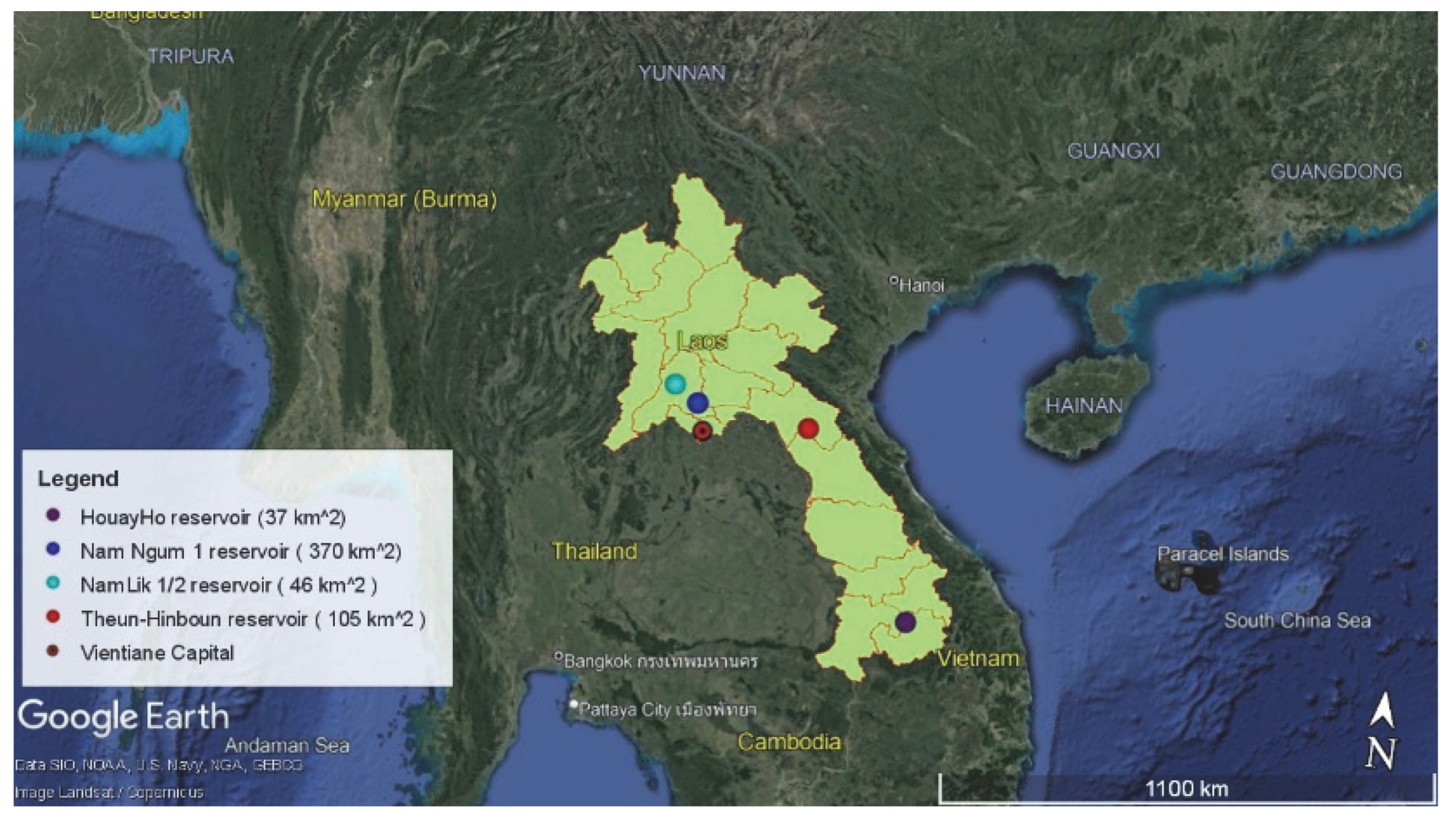
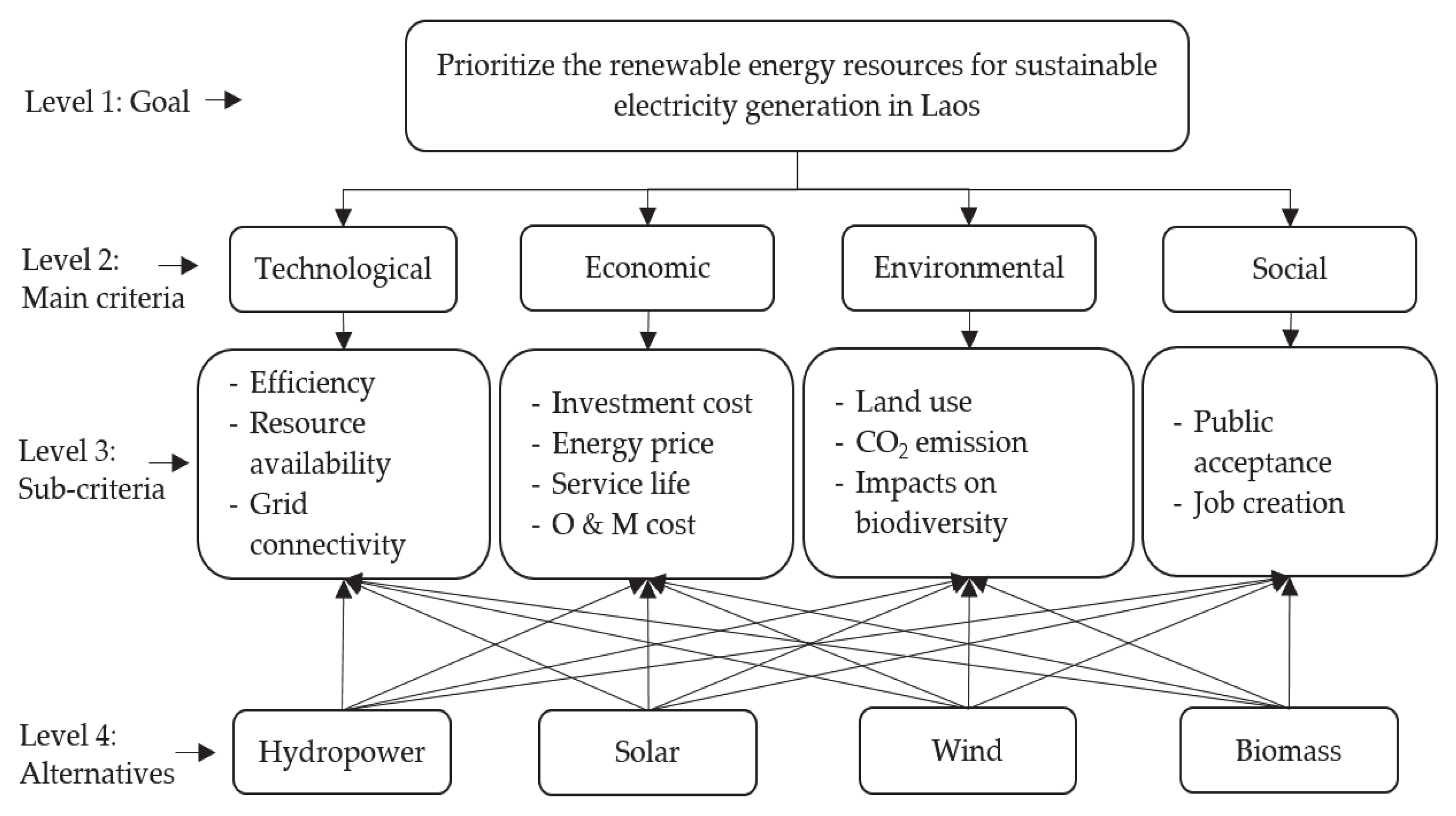


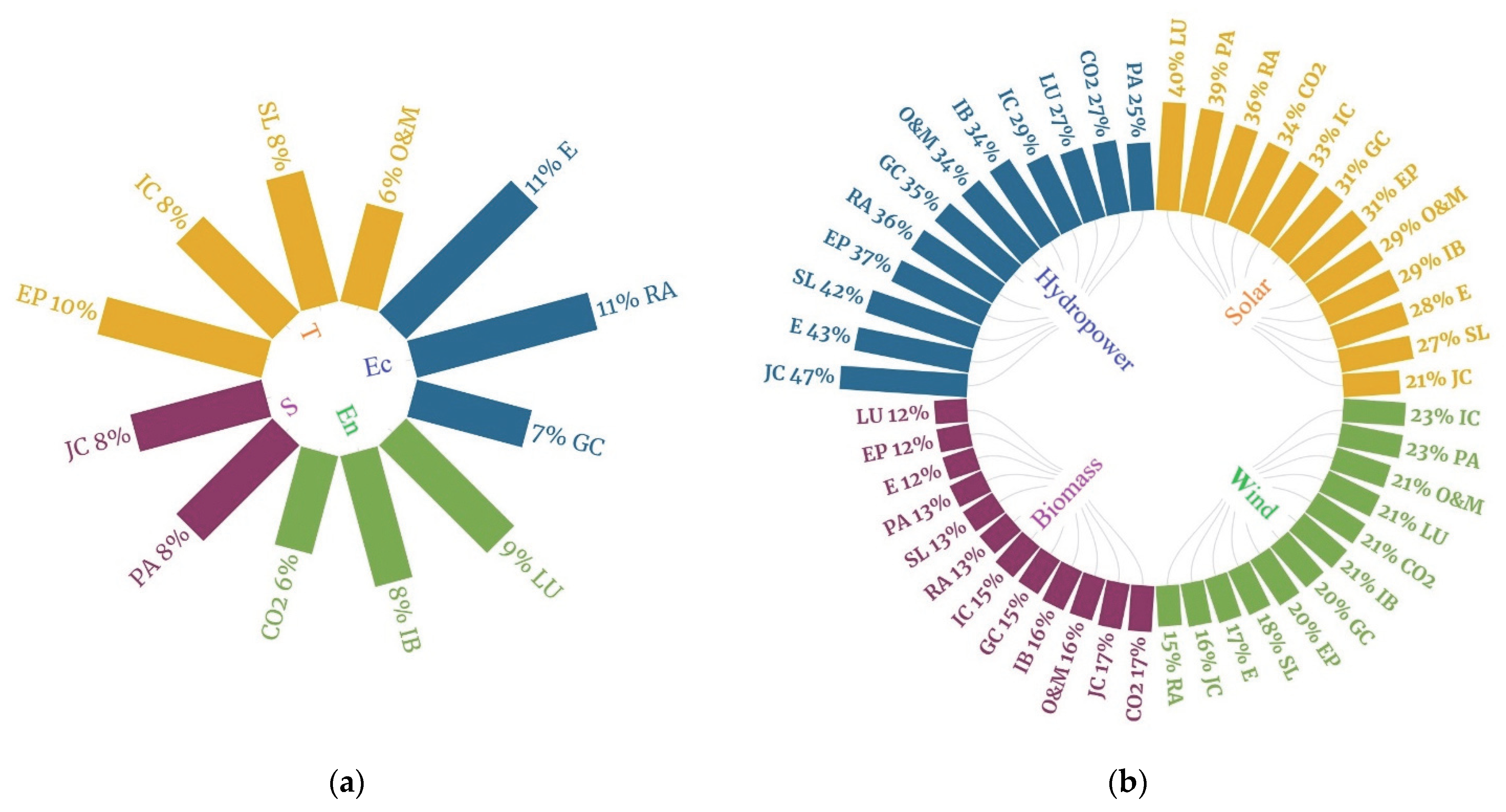
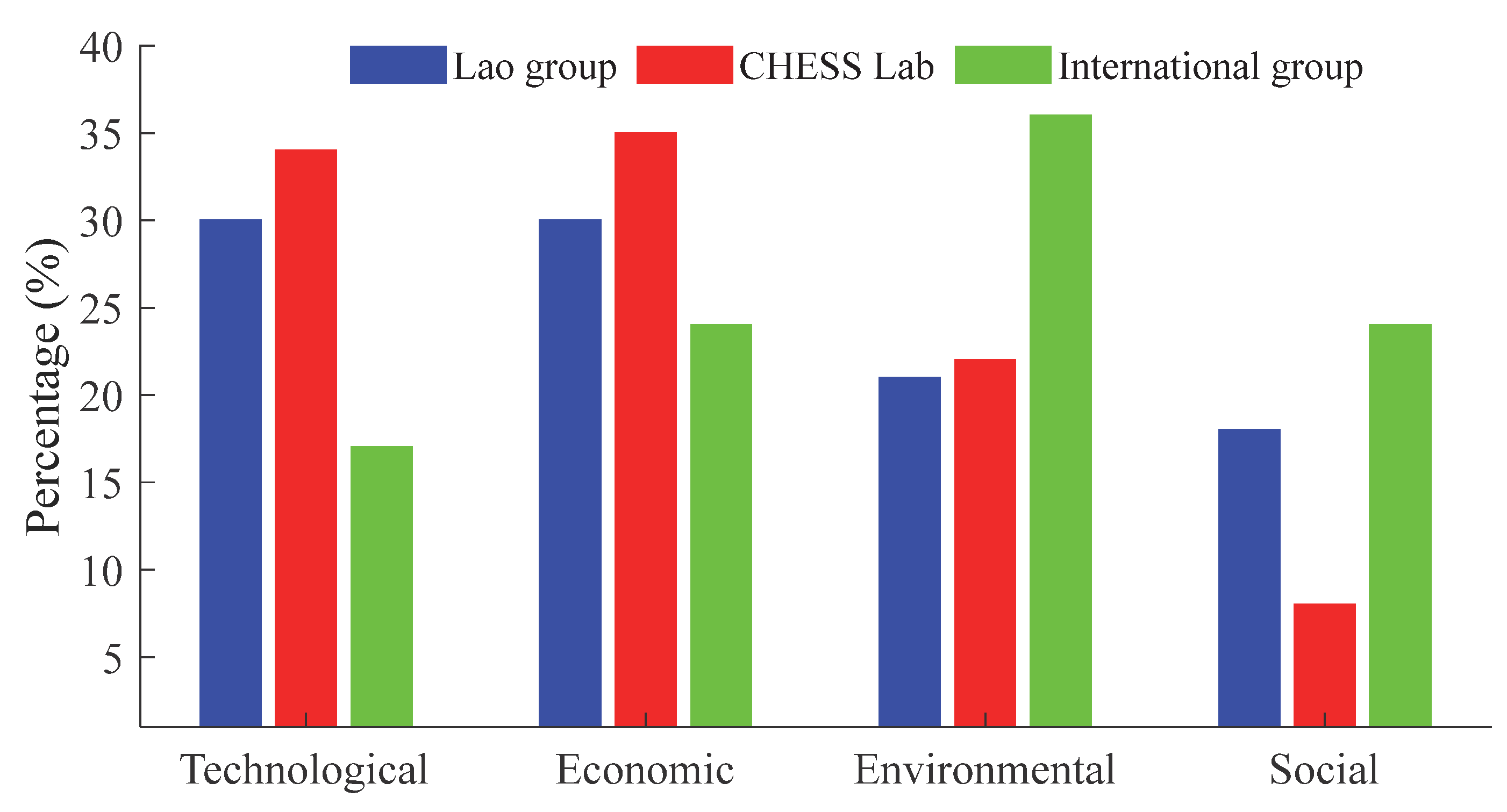

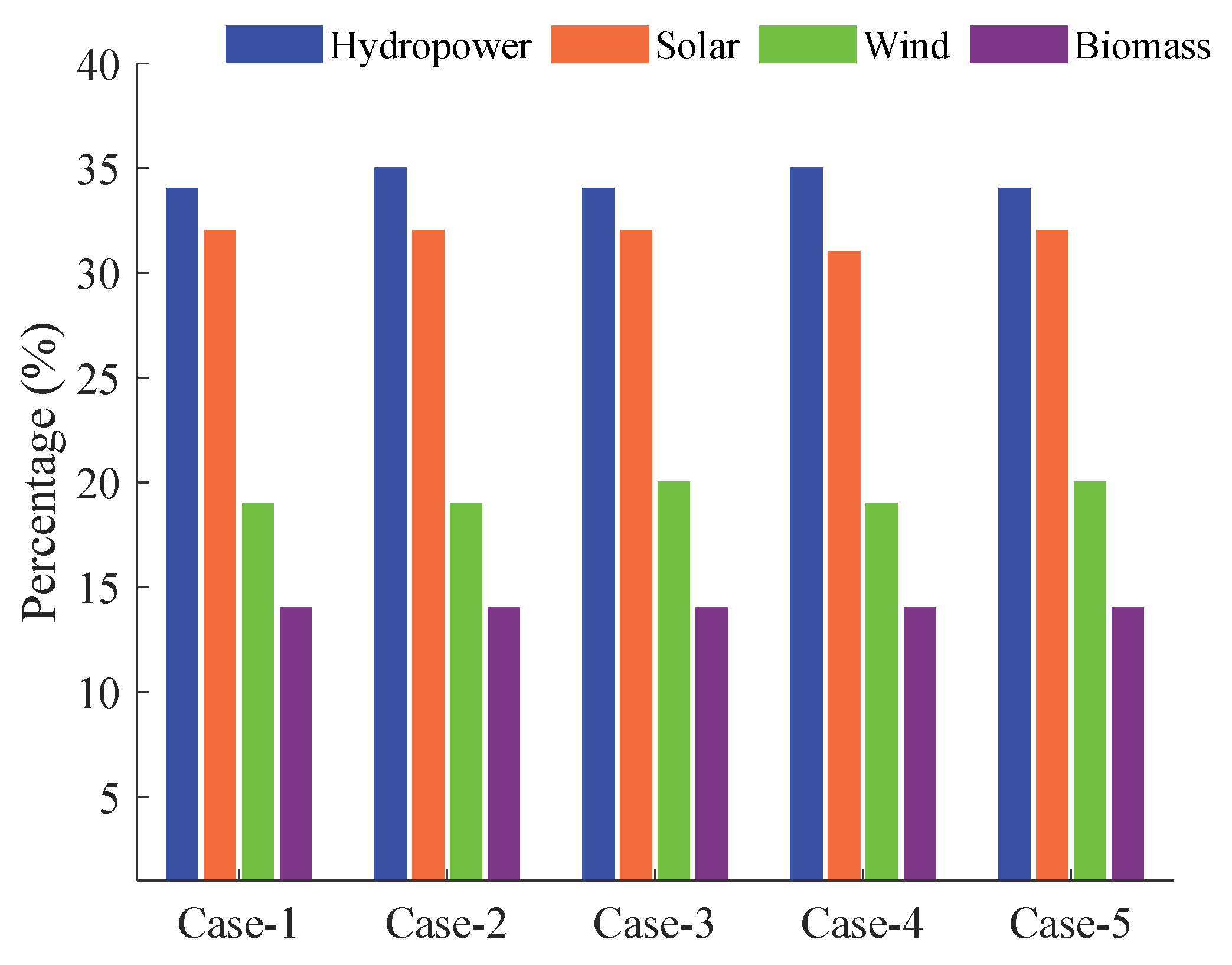

| Alternatives | Description |
|---|---|
| Hydropower | The electricity generated from the hydropower plant |
| Solar | The electricity generated from the solar power plant |
| Wind | The electricity generated from the wind power plant |
| Biomass | The electricity generated from biomass power plant, such as agricultural crops |
| Main criteria | Description |
| Technological (T) | Refers to the substantial energy resources and the capability to generate and supply electricity |
| Economic (Ec) | Refers to the cost effectiveness and robustness of the power project |
| Environmental (En) | Refers to the environmental impacts of the power project |
| Social (S) | Refers to the community impacts of the power project |
| Sub-criteria | Description |
| Efficiency (E) | Refers to the effectiveness and capacity of the energy output from the power project |
| Resource availability (RA) | Refers to the accessibility to energy resources for electricity production |
| Grid connectivity (GC) | Refers to capability to connect to the power system |
| Investment cost (IC) | Refers to the total cost of the power project |
| Energy price (EP) | Refers to the price of electricity generated from the power project |
| Service life (SL) | Refers to the robustness or durability of the power project |
| Operation and maintenance cost (O&M) | Refers to the expenses for operating and maintenance of the power plant after being constructed |
| Land use (LU) | Refers to the land area required for the power project |
| CO2 emission (CO2) | Refers to the pollutants released from the power project that contaminate the atmosphere |
| Impacts on biodiversity (IB) | Refers to the effects or consequences caused by the power project, for instance, the destruction of forests, wildlife, fish, etc. |
| Public acceptance (PA) | Refers to the willingness and collaboration of the local community on the power project |
| Job creation (JC) | Refers to the employment opportunities that the local communities could gain from the power project |
| T | Ec | En | S | Weights | CR | |
|---|---|---|---|---|---|---|
| Technological (T) | 1 | 1.12 | 1.09 | 1.88 | 0.297 | 0.016 |
| Economic (Ec) | 0.89 | 1 | 1.78 | 1.70 | 0.311 | |
| Environmental (En) | 0.92 | 0.56 | 1 | 1.66 | 0.234 | |
| Social (S) | 0.53 | 0.59 | 0.60 | 1 | 0.158 |
| NPDS 2021-2030 | This study | |
|---|---|---|
| Main criteria | Power supply security | Technological |
| Economic | Economic | |
| Environmental | Environmental | |
| Social | ||
| Sub-criteria | Energy price, grid connectivity, efficiency, investment cost, resource availability, land use, job creation | Resource availability, efficiency, energy price, land use, public acceptance, impacts on biodiversity, service life, investment cost, job creation, grid connectivity, CO2 emission, operation and maintenance cost |
| Alternatives | Hydropower | Hydropower |
| Coal | Solar | |
| Solar | Wind | |
| Biomass | Biomass | |
| Wind |
| Alternatives | Fuzzy AHP Weights | AHP Weights | ||
|---|---|---|---|---|
| Hydropower | 0.155 | 0.350 | 0.794 | 0.35 |
| Solar | 0.138 | 0.316 | 0.715 | 0.32 |
| Wind | 0.086 | 0.195 | 0.448 | 0.19 |
| Biomass | 0.061 | 0.139 | 0.324 | 0.14 |
Publisher’s Note: MDPI stays neutral with regard to jurisdictional claims in published maps and institutional affiliations. |
© 2022 by the authors. Licensee MDPI, Basel, Switzerland. This article is an open access article distributed under the terms and conditions of the Creative Commons Attribution (CC BY) license (https://creativecommons.org/licenses/by/4.0/).
Share and Cite
Nhiavue, Y.; Lee, H.S.; Chisale, S.W.; Cabrera, J.S. Prioritization of Renewable Energy for Sustainable Electricity Generation and an Assessment of Floating Photovoltaic Potential in Lao PDR. Energies 2022, 15, 8243. https://doi.org/10.3390/en15218243
Nhiavue Y, Lee HS, Chisale SW, Cabrera JS. Prioritization of Renewable Energy for Sustainable Electricity Generation and an Assessment of Floating Photovoltaic Potential in Lao PDR. Energies. 2022; 15(21):8243. https://doi.org/10.3390/en15218243
Chicago/Turabian StyleNhiavue, Yevang, Han Soo Lee, Sylvester William Chisale, and Jonathan Salar Cabrera. 2022. "Prioritization of Renewable Energy for Sustainable Electricity Generation and an Assessment of Floating Photovoltaic Potential in Lao PDR" Energies 15, no. 21: 8243. https://doi.org/10.3390/en15218243
APA StyleNhiavue, Y., Lee, H. S., Chisale, S. W., & Cabrera, J. S. (2022). Prioritization of Renewable Energy for Sustainable Electricity Generation and an Assessment of Floating Photovoltaic Potential in Lao PDR. Energies, 15(21), 8243. https://doi.org/10.3390/en15218243







